
Hiking Around Las Vegas, Gold Butte National Monument

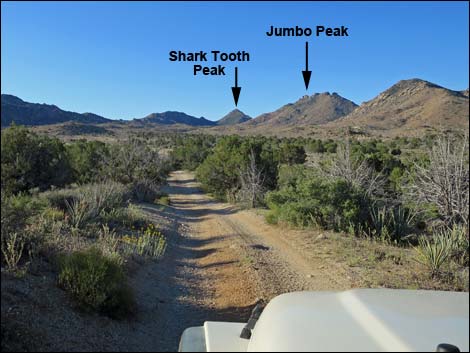 Shark Tooth and Jumbo peaks at the head of Cedar Basin (view S) |
Overview Jumbo Ridge Highpoint (5,692 ft) is the highpoint on Jumbo Ridge, but not the summit (5,761 ft). The summit is a tower of 5th-Class granite that is inaccessible to most hikers. The Highpoint, however, provides all of the hiking excitement (but excludes climbing excitement) achieved by summit climbers with views every bit as grand and expansive as those from the summit. Jumbo Ridge Highpoint, located at the south end of Gold Butte National Monument, is extremely remote, steep, and rocky, but once hikers make it to the trailhead, the route is obvious to follow: up sideslopes winding among rocky outcrops to the ridgeline, then north along the ridgeline to the highpoint. Views from the Highpoint are spectacular and extend across Cedar Basin to the north, as well as southeast into the Grand Canyon and southwest to peaks in southern California -- pretty much the same as those from the true summit. Link to map. |
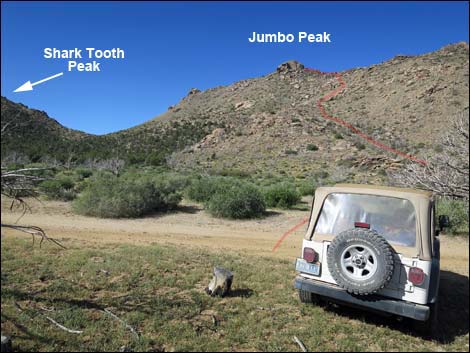 Shark Tooth--Jumbo Peak Trailhead (view SW) |
Watch Out Other than the standard warnings about hiking in the desert, ... this is a wild and remote area without services of any kind (no restrooms, no water, no gas, no food). Bring what you need to survive. Be prepared and be self-reliant. It is a big place, and someone will eventually find you if you stay on a main road, but be prepared to survive alone for a day or two, or even longer on side roads. Consider signaling the tourist helicopters that traverse the area coming and going from the Grand Canyon. This hike is relatively safe, but be extra careful on rocky outcrops on the highpoint where hikers could fall, as help is a long way off. While out, please respect the land and the other people out there, and try to Leave No Trace of your passage. Also, this is a remote area, so be sure to bring the 10 Essentials. |
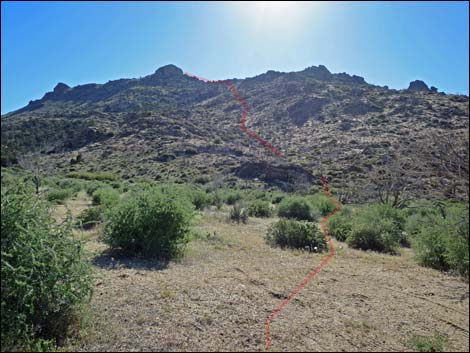 Direct route runs up the side of the ridge (view W from trailhead) Direct route runs up the side of the ridge (view W from trailhead) |
Getting to the Trailhead Jumbo Ridge Highpoint is located out in Gold Butte National Monument at the northeast end of Lake Mead, about 3.5 hours northeast of Las Vegas in a wild, remote, and scenic area. From town, drive out to Gold Butte National Monument. From Whitney Pocket, continue south on the unpaved Gold Butte Road to Gold Butte Townsite. From there, Scanlon Road is the main road running southwest. Drive south on Scanlon Road for 1.9 miles to Quail Springs Wash (watch for a flash flood warning sign). Turn left and drive up Cedar Basin Road, which follows Quail Springs Wash into Cedar Basin. At 3.3 miles out, Cedar Basin Road forks at a white 55-gallon drum in a forested area, stay right on Cedar Basin Road. Passing historic corrals, Cedar Basin Road continues south into a broad canyon generally following a wash. When the road turns left out of the wash and starts up across the gentle hillside, watch for an open area among burned trees that serves as the trailhead. Don't get too far from the wash. Park here; this is the trailhead. |
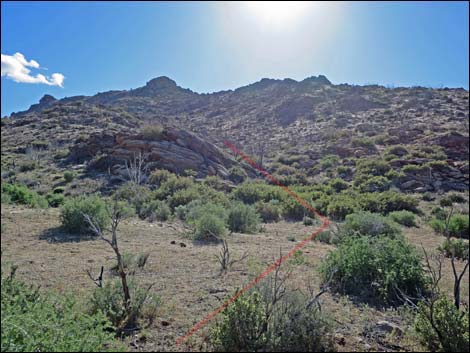 From the wash, the route stays right of rocky outcrop (view W) |
The Hike From the trailhead (Table 1, Waypoint 01), the route runs west to cross the wash (Wpt. 02), then continues southwest and up into a shallow side canyon, staying right of a rocky outcrop. Running up the side canyon, the route passes through an area of skeleton trees that did not survive the last fire. Near the top of the side canyon, the route bends a bit left and climbs onto the adjacent ridgeline, arriving at a flat spot (Wpt. 03) where the top of the ridge blends into the steep slopes of the hillside above. From the flat spot (Wpt. 03), the route ahead can be seen all the way to the crest of Jumbo Ridge, initially aiming southwest towards the north side of the summit tower. After hiking up and across the hillside about 150 vertical-feet, the slope steepens. After a steep 300 vertical-feet, the grade eases as the route enters a flattish, bowl-like area. At this point, adjacent to a large boulder (Wpt. 04), the route turns 90-degrees right to angle up and across (heading northwest) the more-gentle slope. |
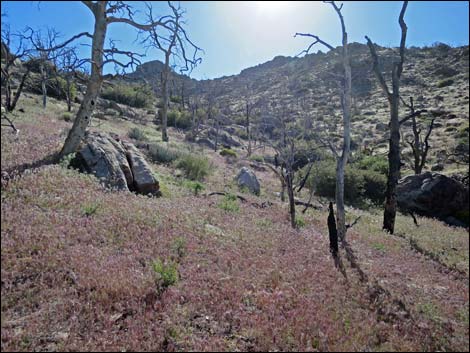 Red Brome grows dense in old burn area |
Ahead, a double-topped false summit looms in the distance. The route climbs over the false summit, passing through the notch on the top. From the false summit, the true summit is a short distance ahead. The route continues northwest and drops into a saddle before climbing the last rocky slopes to the Highpoint. Gaining the Highpoint requires a step or two of 3rd-class scrambling, but hikers who can make it this far won't have trouble. From the Highpoint, the views are spectacular. Hikers can look northeast into the corner of Arizona and maybe Utah, southeast into the Grand Canyon, southwest to high peaks in California, west to Las Vegas, and northwest to the Spring and Sheep ranges. Return to the trailhead by following your footprints back down the mountain, or consider hiking north along the crest of the ridge to the base of the granite tower. Hikers can pass through the tower on the left (east) side and then continue southeast down the ridge into a deep saddle. From the saddle, it is an easy hike down and northeast to the trailhead. |
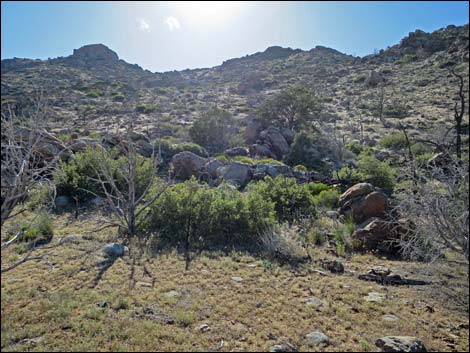 Flat spot (view SW) |
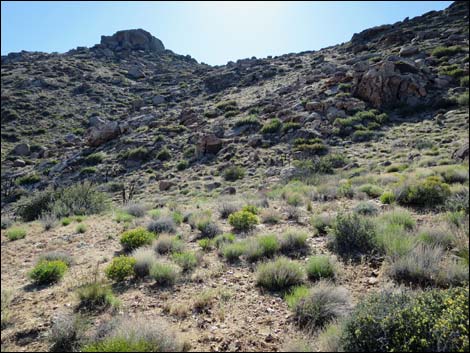 Gentle hillsides become steep (view SW) |
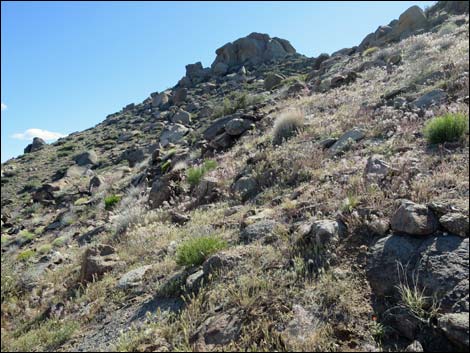 Angling across steep hillside aiming for summit tower (view SW) |
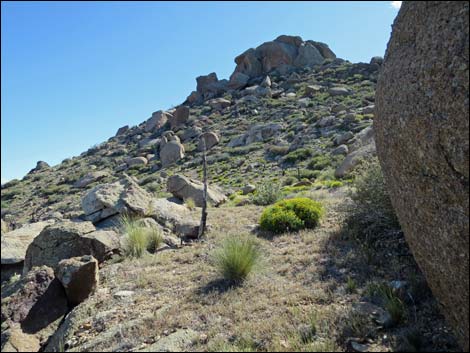 Adjacent to large boulder at top of steep slope (view SW) |
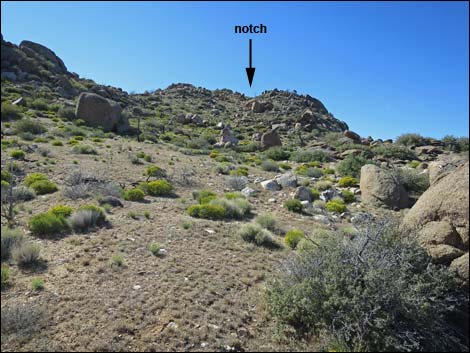 Still adjacent to large boulder, route turn northwest (view NW) |
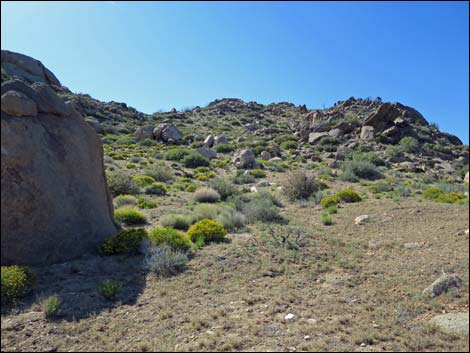 Hiking towards north on false summit (view NW) |
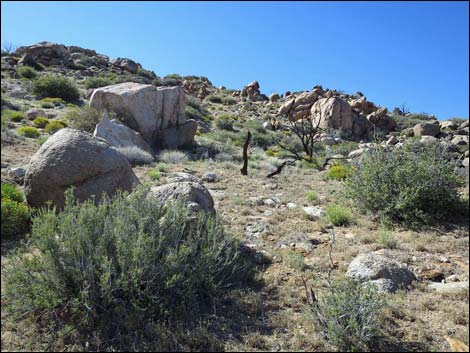 Approaching false summit (view NW) |
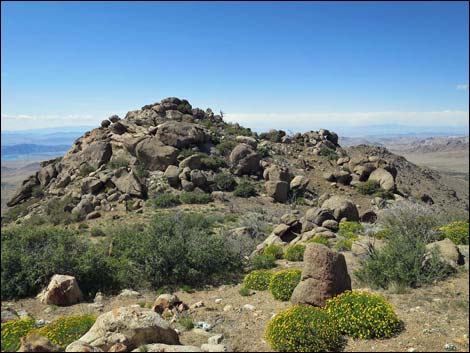 Atop false summit (view NW towards Highpoint) |
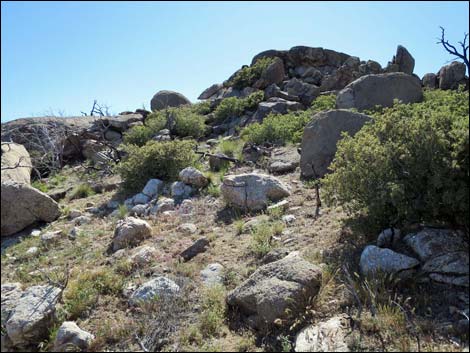 Approaching Highpoint (view W) |
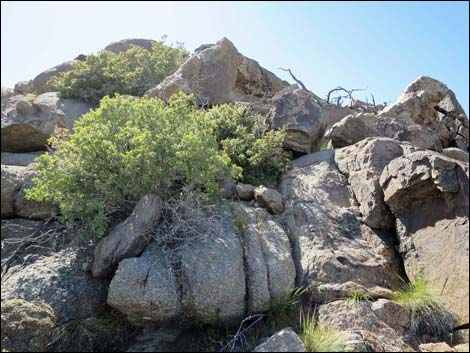 Jumble of boulders at the Highpoint (view W) |
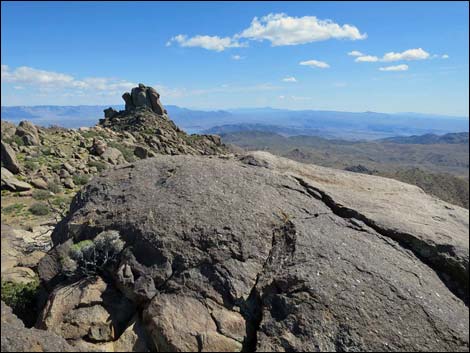 Highpoint (view S towards true summit) |
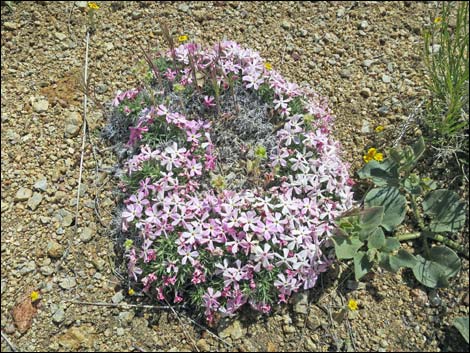 Don't overlook close-ups: Mountain Phlox! |
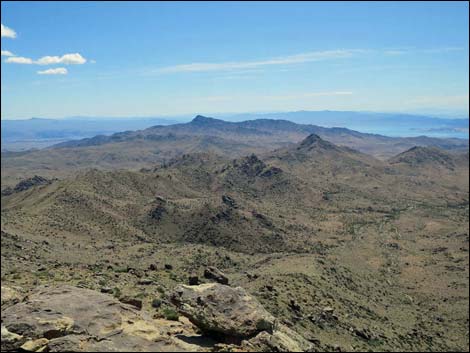 Summit (view SW towards Bonelli Peak) |
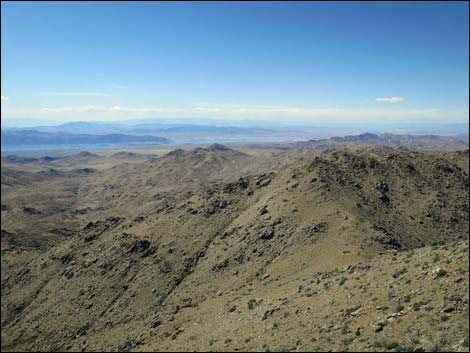 Summit (view NW towards Overton) |
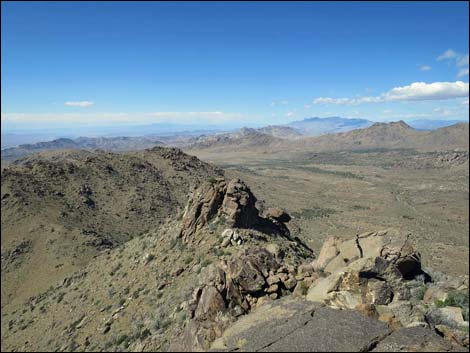 Summit (view N towards Mormon Mountains) |
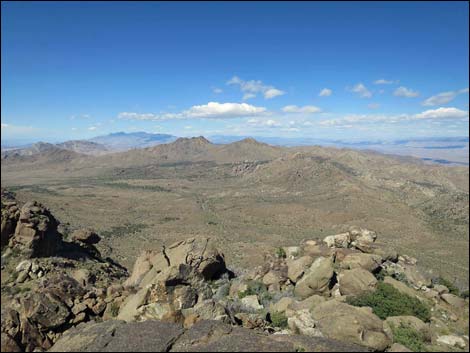 Summit (view NNE towards Virgin Peak and NW Arizona) |
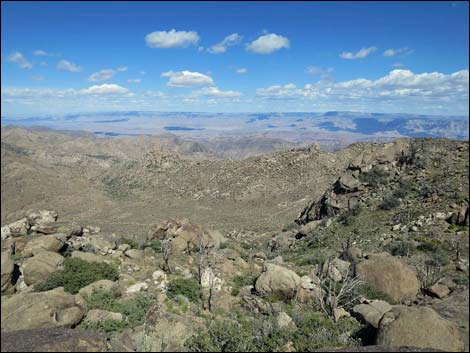 Summit (view E towards Grand Wash Cliffs) |
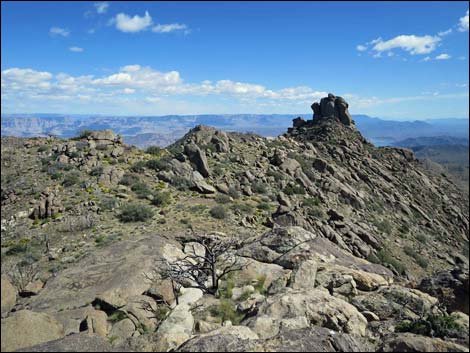 Summit (view SE towards Grand Canyon and Jumbo Peak) |

View Southeast

View southwest

View North

View North-Northeast
Table 1. Hiking Coordinates and Distances based on GPS Data (NAD27; UTM Zone 11S). Download hiking GPS waypoints (gpx) file.
| Wpt. | Location | UTM Easting | UTM Northing | Elevation (ft) | Point-to-Point Distance (mi) | Cumulative Distance (mi) | Verified |
|---|---|---|---|---|---|---|---|
| 01 | Jumbo Peak Trailhead | 754281 | 4010898 | 4,685 | 0.00 | 0.00 | GPS |
| 02 | Wash Crossing | 754197 | 4010889 | 4,678 | 0.05 | 0.05 | GPS |
| 03 | Flat Area Atop Ridge | 754026 | 4010739 | 4,834 | 0.18 | 0.23 | GPS |
| 04 | Route Bends | 753618 | 4010549 | 5,370 | 0.39 | 0.62 | GPS |
| 05 | Jumbo Ridge Highpoint | 753345 | 4010772 | 5,679 | 0.29 | 0.91 | GPS |
| 01 | Jumbo Peak Trailhead | 754281 | 4010898 | 4,685 | 0.91 | 1.82 | GPS |
Happy Hiking! All distances, elevations, and other facts are approximate.
![]() ; Last updated 240325
; Last updated 240325
| Hiking Around Las Vegas | Gold Butte | Glossary | Copyright, Conditions, Disclaimer | Home |